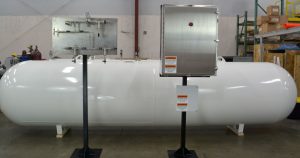Here are three simple steps to select the proper odorization system for an application. We also list the pros and cons of three different types of odorizers: chemical injection (e.g., mercaptan injection), chemical vaporization, and pulse bypass, along with manufacturers (GPL, King Tool, Preco, Welker Systems, and YZ Odorizer) of those styles.
Step 1: Gather your odorization application’s information.
- Gas type needing odorization
- Application (e.g., the transmission line, methane producer, farm tap, and so on)
- Installation location (site dimensions)
- Understand the gas properties
- Pressure range
- Does the gas pressure fluctuate frequently? (If yes, fluctuation range)
- Ambient temperature range
- Gas flow range (MMCF/hour)
- Max operating pressure
Step 2: Review odorization system types’ pros and cons
Natural Gas Odorant Injection System
Odorant injection systems odorize natural gas at transmission pipelines, cities, municipalities, medium-size loads, city gate stations, methane producers, and low-volume applications. The chemical injection pumps are actuated differently depending on the manufacturer. They can be pneumatically actuated, solenoid-driven, or electrically driven to inject a known odorant volume into the gas.
GPL Odorizers is the first manufacturer to introduce a zero-emissions odorizer system. Preco and most Welker and YZ Systems utilize the pipeline gas to actuate the system, though YZ and Welker have recently introduced new eco-responsible alternatives.
With a chemical injection system, the gas becomes odorized by adding small volumes of liquid odorant into the flowing gas. In this odorant injection style, a computer controller monitors the flow, which will vary the injection rate.
Advantages of chemical Injection
- Accurately odorizes gas over wide flow ranges
- Built-in alarms
- Remote control access from computers
- Audit trail to demonstrate proper odorization rate and proof of continuous odorization
Disadvantages
- Susceptible to lightning damage and backup power required for outages
- It is not usually considered for low volumes as there may be too much time between injection doses; however, GPL Odorizers provide uniform odorant injection for low flow (even no-flow).
- More costly than evaporative systems
Four US odorant injection system manufacturers
- GPL Odorizers – Only manufacturers odorization equipment and the first to offer zero emissions and no smell operation
- PRECO – In business since 1969
- Welker – Both pump and pumpless odorant injection
- YZ Systems – top-selling and most popular odorant injection system
Vaporization Systems
Two standard vaporization systems are the wick-type and bypass-type.
Wick Type Odorizer
The wick-style system is one of the oldest types for low-volume applications of less than 500 SCFH. The wick-style unit is known as a “farm-tap” odorizer and perhaps the only way to odorize a single customer. They are for camps, trailers, instrumentation leak detection, and domestic farm taps. These small units are installed on a service line near the gas meter. A wick inserts into the odorant and becomes saturated, and the opposite end extends into the gas stream. The odorant draws up the wick and evaporates into the gas, creating the desired smell.
Advantages of wick type
- Simple to use
- Farm-tap
- Inexpensive
Disadvantages
- Only suitable for low flow and consistent flow applications
- Gas can become over odorized during periods of low flow, such as summer months
- Gas can be under odorized in winter when gas flow is high
- No tracking ability, and challenging to monitor
- Susceptible to liquid contamination (contamination will impede odorant vaporization)
Bypass Systems
The bypass unit is for a small or low-volume system. Part of the gas stream diverts to a tank containing a liquid odorant in this process. Most of these systems include wicks to increase vaporization. The amount of gas diverted depends upon the gas flow. The gas flows through the odorant tank, and when exiting, it is saturated and returns to the gas pipeline, odorizing it.
Advantages of Bypass
- Efficient
- Economical
- Easy to fill, install and replace
Disadvantages
- Not accurate during wide gas flow variations
- Inaccurate when odorant is contaminated
- Will stop odorizing in freezing temperatures if water contaminates the odorant.
- Requires monthly inspection
- Releases odorized gas to the atmosphere with each tank refill.
Chemical vaporization manufacturers in the United States
- King Tool – wick type and bypass
- Peerless – bypass
Pulse Bypass
The pulse bypass odorizer is a variation of the vaporization system worthy of mention.

The pulse bypass is a modified bypass unit that permits tracking the gas flow. Here, the higher-pressure gas from a pipeline introduces odorant vapors into a lower-pressure distribution line. The gas is saturated by diverting non-odorized natural gas through an odorant tank, then returning to a downstream distribution pipeline. This style is suitable for lower flow applications, and while it is more expensive than the traditional bypass, it is less costly than feature-rich chemical injection systems.
Pulse bypass odorization system manufacturers in the United States
- Preco
- Welker
Step 3: Call the appropriate odorizer manufacturers
Review your gathered application information and determine which system type (or types) best aligns with your needs. Call the manufacturers in those system type(s) to discuss your application. We recommend that you request quotes from more than one company.
Here are the phone numbers to make things easier for you:
| Company | Phone | Odorant Injection | Vaporization | Pulse Bypass |
| GPL Odorizers | (303) 927-7683 | ✔ | ||
| King Tool | (903) 759-4478 | ✔ | ||
| PRECO | (402) 493-3337 | ✔ | ✔ | |
| Peerless/CECO | 214-357-6181 | ✔ | ||
| Welker | (281) 491-2331 | ✔ | ✔ | |
| YZ Systems | (281) 362-6500 | ✔ |
If you have questions about using an odorant injection system, contact us.



